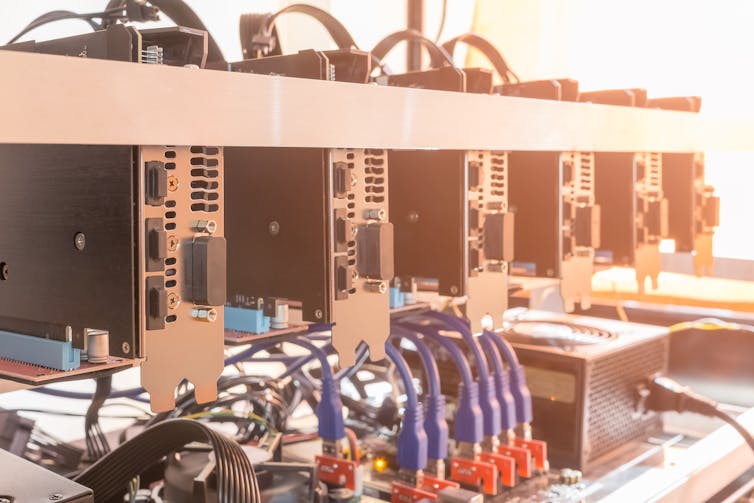Why energy-sapping bitcoin mining is here to stay

Courtesy of Michel Rauchs, Cambridge Judge Business School
The enormous use of energy needed to mine bitcoin and other cryptocurrencies is proving to be very contentious, but alternative methods pose far too much of a security risk.
The recent warning that electricity use at bitcoin mining facilities in Iceland may exceed that consumed annually by the country’s homes, which could in turn lead to a potential energy shortage, was slightly alarmist in tone. But it showcases the huge amount of computational power needed to mine cryptocurrencies.
Is the current cryptocurrency mining process really as wasteful and “useless” as critics say, and is it in need of a more efficient and cleaner system?
The current mining process is indeed resource-intensive and wasteful, but there is no magic fix in sight. Many would argue that it’s precisely the “useless” nature of cryptocurrency mining that keeps the system secure.
Bam! PoW! Zap!
Cryptocurrencies are based on a globally distributed ledger shared among all participants in a decentralised network. This ledger is generally organised in the form of a cumbersome data structure – the blockchain – which consists of blocks of transactions that are cryptographically linked to each other. Most cryptocurrencies use a particular mechanism, dubbed proof-of-work (PoW), to determine which participant gets the right to add a new block of transactions to the blockchain.
To prevent dishonest participants from creating multiple identities to manipulate the public vote, PoW requires participants – called miners – to use special software to solve an extremely difficult cryptographic puzzle. In simple terms, solving the puzzle involves guessing a random number between zero and an infinitely large number.
It demands a lot of computational power because, as more machines are used, a miner can quickly try different combinations and increase the odds of solving the puzzle. But cryptocurrency mining comes at a cost in the form of custom hardware and electricity consumption.
Bitcoin miners alone produce tens of quintillion guesses – known under cryptographic terminology as “hashes” – per second. This gargantuan number has risen in tandem with the amount of energy that has been consumed. The main point of contention is that performing these computations doesn’t serve any useful or productive purpose outside of cryptocurrency mining itself.
But attempts to address the seemingly wasted computing power generated by bitcoin mining have largely fallen flat.
Projects over the past few years include Primecoin, a cryptocurrency launched in 2013 that incentivises miners to find a particular sequence of prime numbers. The same year, Gridcoin was launched to reward people for contributing to scientific research projects by requiring miners to perform scientific computations on BOINC, the Berkeley open infrastructure for network computing.

A rig using graphic cards to mine for cryptocurrency. Shutterstock
SolarCoin was established in early 2014 to incentivise the generation of solar electricity, and the following year students created MangoCoinz as part of a computer science project that aims to reward miners for performing actual physical work.
But, after initial excitement, all these projects had limited success and are only marginally used today.
More recently, the concept of “virtual mining” has also emerged to address the high energy consumption of cryptocurrency mining by removing the need for performing computations altogether. This works by tying a miner’s vote proportionally to their cryptocurrency holdings – an approach that became known as proof-of-stake (PoS).
But it’s unclear, according to previous research, whether pure PoS systems can achieve the same high security standards as PoW and there have been incidents to accentuate such doubts. In 2014, it was reported that stolen cryptocoins could be used to attack PoS-based networks. A hack at an exchange controlling 30% of the monetary supply of the cryptocurrency VeriCoin, prompted the project’s developers to implement an emergency measure – rewriting parts of the transaction history – to prevent the hacker from using the stolen coins to attack the blockchain network.
So – for now – PoW remains the best available mechanism to maintain and secure decentralised cryptocurrency systems. Many believe that mining, while energy-sapping, should remain resource-intensive to make it prohibitively expensive for any single entity to gain sustained control over the decentralised system.
![]() Given how quickly computing technology develops, perhaps an alternative method will be found. Until then, we appear stuck – for better or worse – with a drain on computational systems and energy resources to power bitcoin and other cryptocurrency networks securely.
Given how quickly computing technology develops, perhaps an alternative method will be found. Until then, we appear stuck – for better or worse – with a drain on computational systems and energy resources to power bitcoin and other cryptocurrency networks securely.
Michel Rauchs, Lead in Cryptocurrency and Blockchain, Cambridge Centre for Alternative Finance, Cambridge Judge Business School
This article was originally published on The Conversation. Read the original article.



